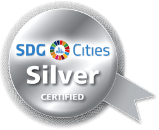August 30, 2024

 Braga
BragaPortugal
175.8k
183 km2
192 m

August 30, 2024
December 19, 2023
September 13, 2023
July 13, 2023
During the Roman Empire, Braca was the capital of the Kingdom of the Suebi, which was known as Bracara Augusta. This was one of the first territories to separate from the Roman Empire in the 5th century.
Braga is known as the “Rome of Portugal” because of its more than 30 churches.
Braga's main attraction is the Sanctuary of Bom Jesus do Monte, located on top of a hill, having to climb over 600 steps to reach it.
The data track ensures that cities can access and use data to describe their baseline on SDG (Sustainable Development Goals) achievement and inform local action. City level statistical data, spatial data and perception data will be collected and analyzed to:
Participating cities will be provided with digital data tools in line with the Global Urban Monitoring Framework.
The strategic planning track ensures that city data merges with community and stakeholder participation to generate inclusive, spatially represented strategic plans for 2030. Participating cities will be provided with guidance based on an existing range of strategic planning tools.
Cities must identify priorities, complete a Voluntary Local Review, and develop a Strategic Development Plan.
In line with the new urban agenda, this track aims to ensure adequate local systems and institutional capacities in areas of governance; integrated urban and territorial planning and design; effective revenue and finance; and effective, equitable urban basic services. participating cities will be provided with digital diagnostic tools and training materials and will be connected in learning communities with cities with similar capacity development priorities.
This track supports the financing of high impact projects in cities through the Cities Investment Facility, comprising of:
Coming soon.